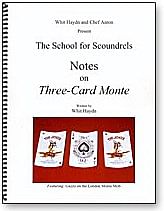Notes on Three-Card Monte by Whit Haydn
Reviewed by Jamy Ian Swiss (originally published in Genii November, 2001)

Whit Haydn is a full-time professional out of Los Angeles, well known to most working pros (at very least) for his comedy "Linking Ring" routine, which has become a contemporary standard. Along with colleague Chef Anton, a trade-show performer who specializes in trick billiard shot demonstrations along with some magic, the two have created a "School for Scoundrels" which offers classes through the Magic Castle in the famous short cons of the "Shell Game," "Three-Card Monte," and "Fast and Loose" (a.k.a., the "Endless Chain"). Previously they have released excellent manuscripts on the Chain and on the Shell Game, along with some accessories including but not limited DO various chains and metal shells; Mr. Haydn has also released a well-received set of Color-Changing Knives.
These two items comprise Mr. Haydn's latest literary efforts. Although I didn't have the opportunity to review the two prior "School for Scoundrels" manuscripts, I greatly enjoyed them both. I offer as no criticism of them, however, my opinion that this new booklet is the best of the trilogy. It is simply that it is that good.
I've been interested in "Three-Card Monte" for a long time. Living in New York City, I have seen the game played on the street hundreds of times. I've seen big money go on the bent corner; I've seen dealers busted; I've even taken an operator for 20 bucks (which I do not recommend). I've also performed the Monte for many, many television appearances, both national and overseas, not to mention of course in countless live appearances. I've read everything on the Monte I could ever get my hands on. And I can tell you: This is the best single reference on the Monte to date.
This doesn't mean that this one manuscript contains everything extant of interest or merit, nor that you shouldn't read other material that's not included here. There are wonderful routines for the Monte in the literature, including those by Dai Vernon, Darwin Ortiz, and Roy Walton. There is definitive material by John Scarne, and the timeless description in Erdnase. There is street work that still remains to be published. But it can now be safely said that if you haven't read Notes on Three-Card Monte, then you haven't read enough.
The book opens with a provocative preface in which the publishers put forth the theory that magic, to its detriment, has been overly influenced by the mentality of the card cheat, while it has paid too little attention to the psychology of the short con scam artist, because the streetwise swindler is concerned about the psychology of the mark and the multiple requirements of creating and holding interest and attention, disarming defenses, and engaging both intellect and emotion. And all these requirements are shared by magicians!
An excellent historical segment begins the book, drawn from many classic sources that the student will find of much use and interest, and which are quoted from at length elsewhere in the book. This is followed by some definitions, clarifying the difference between open Monte (which anyone can gain access to, typically on the street) and closed Monte (typically created specially for an intended target who is singled out and isolated for the purpose), and then descriptions of boxes and other working street setups. This material comprises about 30 pages; the next segment, of approximately equal length, launches into detailed technical descriptions of sleight-of-hand techniques, including street moves as well as conjuring techniques.
The next 20 pages addresses "Hooks and Come-Ons," strategies designed to get players interested; along with street techniques like the bent corner (which can be used both as a hook or as a final score), various outlandish dodges like paper clips and torn corners are covered, and a remarkable bent corner variation from longtime street veteran Gusto that many will be eager to try out. Also included in this section is work on pencil marks and other daubs, and Bob Kohler's "Knifed!" a commercial and mystifying performance piece.
The book continues with chapters on Psychology and Shills; Monte Patter; Three-Card Monte in Film; Monte and the Law (including interesting interviews with law enforcement officials around the U.S.); and a complete routine by the author (which is hampered by the paucity of illustrations). Appendices include a variety of colorful anecdotal material drawn from famous historical sources as well as contemporary encounters. Gambling expert and cardician Ron Wohl contributes a piece on "How to Photograph Three-Card Monte and the Shell Game" on the street, and a number of his photographs are used throughout the book. There is really little more to add: On the subject of the Monte, this book is now a must. The publishers write that eventually they plan to produce a complete volume incorporating all three of their short-con manuscripts, and that will certainly be a must-have achievement when the time comes.
